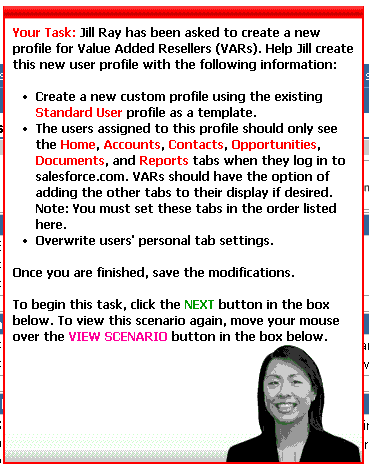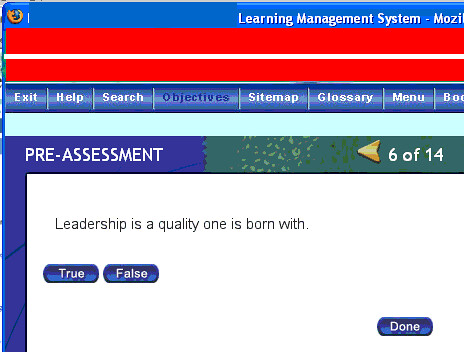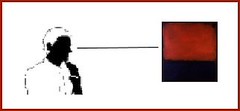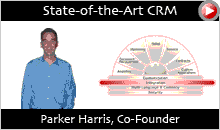Thursday, June 30, 2005
1.800.NO.SOFTWARE
What if...?
...corporate learning worked like Salesforce.com, the largest customer relationship management system hosted on the web? Well, for starters, it would be big:When CBT Systems became SmartForce, the plan was to offer a hosted, all-you-can-eat service on the web. Unfortunately, in 1999 the web was creaky, broadband was not a given, and web services didn't exist, so SmartForce failed to fulfill its vision. All that has changed. Today business relies on the web, and web services integrate local and remote applications. Many people have broadband in their homes as well as at work.
If your eLearning were hosted on someone else's servers, you wouldn't have to install software on yours. The LMS and analytics would come along as part of the package. You'd always have the latest and greatest version of the software -- they upgrade three times a year. You'd buy as much as you wanted, paying as you go. You'd be outsourcing a lot of headaches.
The beauty of hosting is easier to experience than to explain. Take a look at Salesforce.com and imagine how a platform like this could simplify your life. (No, I'm not getting a commission for this.)
It's the real thing
To get my arms around the Salesforce.com concept, I visited The Demo Center, where a variety of chalk-talk Flash movies introduced basic principles.
For how-to lessons, I went to free courses for users and administrators. Salesforce.com has some practical instructional designers. A combination of case study and simulation of the product get right to the point.

This is a stark contrast to the sort of academic mumbo-jumbo programs I looked through earlier this week. True-and-false was invented for the convenience of teachers. It bears no relationship to learning.

Future installments may include "What if your learning infrastructure were like Amazon?" and "What if...Google?" Any other suggestions?
2001 Insight
John Stephenson Head, International Centre for Learner Managed Learning, Middlesex University
Questions
This evening I asked myself what it was like to learn something. If learning = fit with environment, it's meaningless without it. So imagine it's me and a trio from the community. I ask if I can do something; a member of the trio says "no." I may learn not to ask in the future or that what I'd asked goes against the social code of the trio. The nay-sayer may have learned that I'm polite enough to ask. Or he may have learned that I'm a wimp. Or he may have simply interpreted the code of conduct that he knows and I do not.
Learning is in the eye of the beholder. All learning is relative.
Also, when learning is defined as improving fit with the environment, unlearning and reinterpretation can be as important as acquiring new information.
Wednesday, June 29, 2005
Life in the Corporation

The human brain is a trickster. It has to be. If it weren't rejecting 99.99% of the input bombarding our senses, our heads would explode from sensory overload.
Our brains convince us that what we see is real, while it's actually an illusion our consciousness makes by connecting the dots.
Neuroscientists reported last week that fMRI tests explained what social psychologist Solomon Asch had discovered fifty years ago . Here's The New York Times' description of Asch's experiments:
In those early studies, the subjects were shown two cards. On the first was a vertical line. On the second were three lines, one of them the same length as that on the first card.
Then the subjects were asked to say which two lines were alike, something that most 5-year-olds could answer correctly.
But Dr. Asch added a twist. Seven other people, in cahoots with the researchers, also examined the lines and gave their answers before the subjects did. And sometimes these confederates intentionally gave the wrong answer.
Dr. Asch was astonished at what happened next. After thinking hard, three out of four subjects agreed with the incorrect answers given by the confederates at least once. And one in four conformed 50 percent of the time.
The fMRI studies showed that people sometimes saw what other people described rather than what was on the cards. They weren't consciously thinking about disagreeing with the group; they reported what they saw.
As the comedian said, "I used to think the brain was the most important organ in the body, and then I thought, 'Hold on. Who's telling me that?'" Indeed, our consciousness tells us we're in control, even when we're clearly not. Back into the fMRI. Say I decide to move my right hand. The brain scanner shows that my hand started to move before I ever thought about it. My "decision" is really an excuse to fool me into thinking I had some choice in this. Often our control over our actions is make-believe.

It's au courant to compare organizations to living organisms. Both are born, grow, flourish, wither, and die. Both consume resources and excrete waste. Both think they are controlled from the top. Both think their actions create future results. Both think they are logical.
What if corporations are as misguided as we humans?
Corporations are no more top-down than humans; the shadow organization alwyas overpowers the organization chart.
What if corporations that think they are empowering workers are simply going along with the trend toward increasing worker freedom?
Are good business results the result of good work or are they happenstance?
Is the frenzied pace of business a needless exercise? Are we putting people through the wringer when we could be putting them on the beach? Shouldn't we be working more wisely instead of ever harder?
 When people get burned out or lose their way or go postal, we prescribe some rest, meditation, a session with a therapist, diversions, drugs, a good sleep, a new way of looking at the world, or maybe shock treatment.
When people get burned out or lose their way or go postal, we prescribe some rest, meditation, a session with a therapist, diversions, drugs, a good sleep, a new way of looking at the world, or maybe shock treatment.Corporations don't do these things. Humans go into fight or flight mode. Corporations do the same, but their power makes them harder to restrain than individuals.
When will corporate investors wake up to the fact that the unexamined life is not worth living?

Personal Project Management
Regarding reading of new information, think of it as dipping your ladle into a flowing stream. If you don't pick it up, let it flow by. You can probably retrieve it downstream if you have a need.
Don't let others call the shots. If you decide what you want to do, you control your life. If you let others -- or whim -- run things, you'll be overwhelmed.
On this book, I've been bouncing around gathering new material. I've read a lot of books and talked with a number of people. I have more people to talk with but I truly need to build the exoskeleton of the manuscript and begin completing the pieces. Enough looking sideways!
EQ
Is that what you mean when you write about “leaning into your discomfort?”
Self-awareness is the No. 1 skill for improving your EQ. There are things that we aren’t aware of for a reason; they are things that make us uncomfortable, and we don’t want to change so we don’t think about them. It’s like making yourself go to the gym. You have to do that thing you don’t want to do. For example, I need to be a more social husband. When my wife tells me an event is optional and I really want to stay home, I go because I know it’s a place where I’m not naturally a good husband.
You also write about how EQ can help people recover from illness. How?
It’s not that emotional intelligence cures breast cancer, but stress does affect your health. There is a simple biological reason: when you get stressed out, your immune system shuts down. People get stressed out about their emotions. They feel bad. But people who have emotional mastery, when something extreme happens in their life, they are OK with it.
Tuesday, June 28, 2005
Augmented World
You know what? The internet changed everything. Or maybe I should say that it's in the process of changing everything. Nay-sayers and a few lame-brained senators point to the dot-com meltdown with a condescending "I told you so" look. Fanatics believe that ubiquitous porn is proof positive that the net is the devil's seed. Some people just don't get it.
Nonetheless, the world has never had anything even close to the internet before. Soon you'll have a pocket-sized device with access to anyone and just about any information on earth. Distance doesn't matter. Virtual reality is poised to make a comeback. The internet is the great equalizer, the flattener of playing fields and the avatar of individual freedom.
From here on, the issue is not what the worker has committed to memory and can demonstrate on an exam. Rather, it's the power of the worker and her net connection, toolset, social network, and community support that matter. What can they do?
There's no excuse not to document a meeting. Rather than keep notes manually, etc.
Augmented learners, augmented meetings, augmented advice functions, and automated
structure
Old way story
New way story
Maybe theory
Graphics
Bottom Line
References
Monday, June 27, 2005
http://www.lle.mdx.ac.uk/iclml/njmetasem.pdf
The question ‘what is metalearning?’ begs the question ‘what is learning?’ For the
purpose of this discussion I am adopting and slightly modifying the definition of learning
provided by Davenport and Prusak (2000) ‘a fluid mixture of experience, values,
contextualised information and that provides a framework for evaluating and
incorporating new experiences and information’ and for imagining new things. I have
added the reference to imagination (causing to come into existence) as it seems
particularly relevant to the idea of metalearning as a means of viewing and anticipating
the future. This conception of learning means that although we may encounter the same
experience or be confronted by the same new knowledge the sense we make of it, the
value we place on it and our capacity to make use of it, will be unique to each individual.
Using this reasoning, metalearning - high level conceptions about learning and how we
acquire new learning, must also be unique to each individual.
How do people learn?
Most of the people who contributed to this discussion on metalearning suggested that it
was about understanding how we learn as individuals. It is therefore worth reflecting on
how we learn. Our knowledge about learning is constructed everyday of our lives but we
rarely think about or discuss the many ways in which we acquire our knowledge about
how people learn. I recently did some research for a teaching session on how
professional’s learn with a group of 15 medical General Practitioners at different stages
of their careers and found that between them they used or recognised 44 different
strategies to develop their own learning. The main ways I think I have acquired my
knowledge about how people learn (primarily in the contexts of higher education
teaching, research, educational development and change agency work in higher
education) is mapped in Figure 3.
Figure 3 How I think I have learned about how other people and I learn
my knowledge about
how people learn has
been acquired in
many ways
unprocessed
everyday
experiences that
contribute to my
beliefs and
perceptions
processed experiences in
which I have deliberately
tried to learn about myself
my own formal
learning
reading ‘explicit
knowledge’ about
learning
sharing of tacit
knowledge through
structured
discussions or
informal
conversation
as a bi-product of
collaborative working
scientific knowledge
about how people learn
through collaborative
working that explicitly
tries to reveal how we learn
learning through research
and scholarship connected to
employment eg teacher,
researcher, consultant in a
range of contexts
participation in formal
training, development
activities and events,
conferences, workshops etc..
by observing others
and trying to emulate
what I considered to
be good role models
by engaging in action
research and reflective
processes..
Gagné and more
(Adapted from Gagné, R., Briggs, L. & Wager, W. (1992). Principles of Instructional
Design (4th Ed.). Fort Worth, TX: HBJ College Publishers.)
1. Gain attention
2. Inform learner of objectives
3. Stimulate recall of prior learning
4. Present stimulus material
5. Provide learner guidance
6. Elicit performance
7. Provide feedback
8. Assess performance
9. Enhance retention and transfer
SIDEBAR 2 10 Questions that will lead to cathartic instructional introspection
Principle 1: What cognitive processes (if any!) do your interactions elicit from the
learners?
Principle 2: What (if anything!) can learners get from your course that they could
not get from reading a training manual and taking a multiple-choice quiz
afterwards?
Principle 3: What types of questions did you pose in the analysis phase of the
course, and to whom did you pose them?
Principle 4: How closely (if at all!) do the culminating activities of your course
mirror what learners are required to do on the job?
Principle 5: How much (if any!) of your course content is presented in the form of
contextual feedback on the learners’ performance?
Principle 6: How much ability (if any!) do learners have to choose the sequence and
amount of content they wish to access?
Principle 7: How hard did you really try (if at all!) to devise experiential learning
activities that could fit within your course’s budget?
Principle 8: Is there enough variety among your course activities to garner and
maintain learner engagement?
Principle 9: Aside from the fact that their job may depend on it, is there anything in
the course itself that motivates learners to retain, apply (or for that matter, even pay
attention to) the content being presented?
The $64,000 Question: Would learners who just completed one of your courses
rather be gouged in the eyeball with a hot poker than have to sit through a second
one?
Nice article from eLearning Guild

A Look Over the Shoulder
Roy Pea
Wednesday, June 22, 2005
The Learning Process
Learning is the non-generic adaptation to one's ecosystem. Its measure of success is the successful fit of people with communities that matter to them.

Perceive | Engage | Retain
Let's think of learning as a three-step process. The first step is perception. You've got to be alert to perceive the subtleties of life. You have to pay attention. You need to know your desires well enough to recognize what's worth looking at and what's superfluous.
You've also feel you're in charge. If you watch life go by passively, as if watching television, you won't get much out of it. A curious person is always looking at things from new perspectives. Look closely and you realize that everything in this world is awesome. On a grand scale, you're hurtling around the sun at 38,000 miles per hour. At the opposite end of the spectrum, all matter morphs into waves and particles performing randomly. Somewhere in between these extremes, your mind displays a private, internal movie which is you call consciousness or reality.
Step two is engagement. Our brains filter out all but 1 bit of information in 600,000 bits that bombard our senses. Even then, we don't do anything with this information unless we recognize it as a pattern. Patterns that seem reasonable and that may help us prosper are saved to our short-term memory. If the mind rates the new pattern particularly useful or a good fit with existing patterns, perhaps it will find a home in longterm memory; it will become part of our repetoire. If we don't apply what we've learned or otherwise reinforce remembering it, more than half will evaporate within an hour. Learning requires reflection. Practice is engaging. It connects what you're learning to what you've learned. It wires new things into your existing frameworks.
Step three is fit. The more something we learn helps us prosper, the more likely we are to retain it. Once a mental connection is made, repetition strengthens it. Problems arise when our ecosystem changes and our brains don't change in tandem. Antiquated vestigial programs trip up people who do not consciously work to elminate them. As mal-memes propagate, unlearning becomes a survival skill.
Who's in Charge?
Some people refused to play the game. Buddhists strived to escape to a higher game, by looking at this lifetime as but one move in a larger game where you live many lives. Gurus drop out of the game during their lifetime by reaching nirvana, which involves an entirely new set of rules. Artists, criminals, revolutionaries, psychotics, and other free spirits rebel against the game or simply didn't understand the rules.
These are game-changing times. In the new game that began to evolve when the printing press accelerated the sharing of ideas, individuals decide for themselves the degree to which they play the game or let themselves be played. Opportunity abounds as more and more people become players.
Players are what Harvard psycholgist Ellen Langer calls Mindfulness (Langer, 2005). To be mindful is to be aware, to look at the world through multiple perspectives, and to take responsibility for one's decisions, i.e. to be a player. We all know people who haven't made this leap; they see themselves as victims and pawns. Langer calls these people mindless.
You're going to spend your entire life learning so you might as well get good at it. Embracing mindfulness is your first step. You'll need to be flexible, to look at things through different lenses, to reflect on what you see, to try new things, to run thought experiments, and to pay attention. A mindful person often cuts off the mindless auto-pilot of aimless living to follow Nietsche's advice to "Become who you are!"
This morning, there's nothing on my calendar. Busybody that I am, I use the time to mindlessly work items off of my to-do list. Or I can mindfully start by reflecting on how I'd like to feel at the end of the day. The mindful approach leaves room for new ideas, but the to-do list confines me to old stuff. Naturally, I"m going to try to face the day mindfully.
Monday, June 20, 2005
Design & prototyping
Design thinking is inherently a prototyping process. Once you spot a promising idea, you build it. The prototype is typically a drawing, model, or film that describes a product, system, or service. We build these models very quickly; they're rough, ready, and not at all elegant, but they work. The goal isn't to create a close approximation of the finished product or process; the goal is to elicit feedback that helps us work through the problem we're trying to solve. In a sense, we build to think.
When you rapidly prototype, you're actually beginning to build the strategy itself. And you're doing so very early in the innovation cycle. This enables you to unlock one of your organization's most valuable assets: people's intuitions. When you sit down with your senior team and show them prototypes of the products and services you want to put out in two years' time, you get their intuitive feel for whether you're headed in the right direction. It's a process of enlightened trial and error: Observe the world, identify patterns of behavior, generate ideas, get feedback, repeat the process, and keep refining until you're ready to bring the thing to market.
Streategy by Design by Tim Brown
hagel
friction: learn from diversity. quickly. put people with different deep specialitzaitons together and give them tough assignments. this forces creative solutions. that's learning #1.
dynamic specialization. go for core. continuously. and outsource to world-class providers. that's learning #2.
embrace change.
can no longer defend and extend.
------------------
personal prototyping. draw. model. sketch. explain. tell. do many models so you have a group to choose from. externalize. many patterns before choice. measure fifty times, cut once into idea wood.
Gloria Gery Story
RELEVANCE. a key aspect is time. when you do something too far in advance, you're not sure why you need it. you don't have anywhere to stash it. there's no context. you forget it before you have a chance to use it. that's why learn it when you need it works so well. we're problem solvers. school tries to stuff us with solutions we see no need for.
check forgetting research findings.
can't force learning. you can lead a boy to college but you can't make him think.
Sunday, June 19, 2005
Evectors
Archive List
Duck!
 If you work for a business, be a business person.
If you work for a business, be a business person.T+D (formerly called Training & Development) is the magazine of ASTD ( formerly known as the American Society for Training & Development). The cover story of the current issue tells WLP (workplace learning and performance) professionals that Business Acumen is Priority One.
The article, Build Your Business Acumen, tells us that "Workplace learning and performance professionals need to think and talk like their internal customers." The article advises readers to understand the business and how it operates, to use business terminology to gain credibility, to recognize business priorities, to create a value proposition, and to advance the learning and performance business agenda. Follow the instructions and you can become an Enabler, trusted by management to help run the business.
This is fine advice but it doesn't go far enough. You can do more than sharpening your business acumen, using management's vocabulary, and positioning yourself as an understanding, savvy helper. Instead of acting like a busienss person, why not become one? "Earning a seat at the table" is not enough; you need to be invited back frequently.
 If it looks like a duck, walks like a duck, and quacks like a duck, it's a duck. If a WLP professional looks like a business person, walks like a business person, and talks like a business person, why shouldn't she join a business community of practice and become a business person?
If it looks like a duck, walks like a duck, and quacks like a duck, it's a duck. If a WLP professional looks like a business person, walks like a business person, and talks like a business person, why shouldn't she join a business community of practice and become a business person?Am I being too subtle? You are paid to help create value, not to train people or design learning environments: those are but the means to an end. Make yourself profitable. Add value. Don't fake it. Just do it.

Learning, Improvement, or Both?
Lifehacker
An Incomplete Manifesto for Growth by Bruce Mau
To-Done, Working to Live
Dave Allen
Is this item from Life Hacker improvement or learning?
Activate your central nervous system to get stuff done
FILED UNDER PRODUCTIVITY
Med student dad Bert Webb says that on sluggish days when you can’t get a thing done, activate your body’s central nervous system to kickstart your productivity:
By mimicking the sympathetic reactions to a threatening environment (sitting up straight, standing, moving quickly, deeper breathing), it appears to be possible to activate the sympathetic [central nervous] system, which then takes over. We are ready to act, or in our case, be productive. We can also change our environment to one that causes the sympathetic system to activate, one that is more spartan, threatening, or simply uncomfortable. The result? We take action. We are more productive.
By my definition of learning, that it means achieving fit with one's ecosystem, self-improvement is a sort of learning. Come to think of it, Self Improvement has a positive spin that self-directed learning lacks.




The shelves of the Chapters bookstore in Fredericton, New Brunswick, Canada, are over-flowing with self-help books. (Books on New Age, Occult, Psychology, and Spirituality have separate sections.) When a book helps you function, it must have changed your behavior. A change in behavior that's not genetic in origin means you've learned something.
Lifehacker offers computer information in these catagories:
- Spyware cleaners
- Spam filters
- Virus killers
- Internet phones
- File sharing
- Backup utilities
- Personal organizers
- Photo sharing
- Disk recovery
- Personal finance
- Web publishing
- Search engines
- Life hacks
Saturday, June 18, 2005
SF Museum of Modern Art
 I stopped to contemplate a massive Rothko. This is one of those Rothkos that looks like a window. A big window: it's about 9' by 9'. The top blob is a rich orange; it floats above a deep purple blob.
I stopped to contemplate a massive Rothko. This is one of those Rothkos that looks like a window. A big window: it's about 9' by 9'. The top blob is a rich orange; it floats above a deep purple blob.I've been here before, but I'd never understood why. Something pulled me in, like the Richard Dreyfuss character in Encounters of the Third Kind who builds a mud model of Devil's Tower in his den and then just has to go there. I imagine I've clocked an hour in front of this particular Rothko of the course of six or seven visits. How can a couple of blobs, great blobs but blogs none the less, mesmerize a relatively savvy guy?
I realized I'd been looking in the wrong place. The magic wasn't the canvas and the paint. No, the power comes from the effect this Rothko has on me. It's the Rothko, my perceptions, and how I feel about the Rothko, all wrapped into an experience, that count.
 Hide the Rothko from view and its power disappears. I wander through life, thinking I'm a separate entity, able to stand alone, like I once thought the painting did. Then I awaken, realizing that I'm really no more than the sum of my connections. Hide me from connections to things outside of me and I disappear. Like my relationship with the painting, I'm defined by my bridges to things outside of me.
Hide the Rothko from view and its power disappears. I wander through life, thinking I'm a separate entity, able to stand alone, like I once thought the painting did. Then I awaken, realizing that I'm really no more than the sum of my connections. Hide me from connections to things outside of me and I disappear. Like my relationship with the painting, I'm defined by my bridges to things outside of me.Titanic waves of information continually bombard our senses yet only a trickle makes it to our consciousness. Last night I read about a peculiar art work by Robert Rauschenberg in Ellen Langer's On Becoming an Artist. The story is that Rauschenberg asked Willem de Koonig for a drawing he might destroy. De Koonig, being somewhat old-school about art, very reluctantly agreed. Rauschenberg spent a month meticulously erasing the drawing. Then he framed and exhibited the canvas as Erased de Koonig Drawing, 1953, immediately making his mark at the beginning of a new tradition in art. That's not the punchline.
Walking through a room hung with Jasper Johns, Jim Dine, and Robert Rauschenberg, I spotted a faded painting I hadn't noticed before. It was...you guessed it...Rauschenberg's Erased de Koonig Drawing, 1953. It has been in the collection for three years. I've passed it a dozen times but never saw it. Lots of life is like that.
A one-room exhbit from 2x4 , a design firm in NY, featured a thin flat panel on which the pages of a book were being turned. Faster and faster. It was an intriguing work. Jamming two formats together. Later the same frisson returned when I saw Demuth's "Fountain," the urinal he submitted to a Paris show. Readymade. Ordinary things. I've go plenty of ordinary stuff. I've long considered myself an artist -- in the closet, but an artist.
Friday, June 17, 2005
Lessons from Instructional Designers
In the mid-seventies, when I designed the first business curriculum for the Institute that went on to become the University of Phoenix, there were not many books on instructional design. The discipline was fixated on behaviorism and programmed instruction, that is, applying lessons learned from rats in mazes and pigeons in boxes to human learning.
How things have changed! There are hundreds upon hundreds of worthy books on instructional design. My personal library on learning and instructional design holds 25' of volumes -- and that's after recycling a large chunk of my collection. Numerous universities offer masters and doctoral programs in instructional technology. Corporations invest hundreds of milloins of dollars in Learning Management Systems, Authoring Tools, Automated Testing, and Virtual Classrooms, to mention a few of the technologies involved. As companies have awoken to the fact that learning is the only way to stay ahead of the pack, training has become an important industry.
Why am I telling you this? Oh, yeah. I remember. Squirreled away in the 10,000 or so pages of books and a gigabyte of blogs and notes on my web sites, are some wonderful gems of wisdom about how to learn things. I'm going to try to squeeze the essence of the best and the brightest instructional designers into bite-sized pieces for you to snack on.
Here we go.
Front-end analysis. Begin with the end in mind. When designing a learning experience, start by jotting down what you want to be able to do when you're through. Be specific: do whay, how well, by when?
Is it a training problem? Training is often the fall guy for poorly designed systems, unreasonable expectations, and other management foibles. Ask yourself, "If we held a gun to her head, could she do it?" If they answer is yes, you may have a training problem. Otherwise, the trouble is wrapped up with motivation.
Gap analysis. What's the gap between where you are and where you want to be?
Conception of learning. Arguments still rage over the "right" way to look at learning.
- Behaviorists believe that learning has taken place when a stimulus elicits the desired response. (Bell rings, dog salivates.) While they think the brain mysterious, many think it's probably like a computer.
- Cognitivists think learning is co-created; it requires the active participation of the learner to come to know something. The mental models we've shaped for ourselves shape how we see the world.
- Constructionists believe that learning is entirely within your head: it's the meaning you breathe into something based on your past experience.
- There's a bit of truth to each of these. Learning may be mandated from outside; learning may result from sharing; learning is what ends up in the learner's head. Figuring this out is usually a three-credit course. You have my permission to forget it.
Collaborative Learning. You and a friend learning from, say, a computer-mediated course, will learn more than either of you would by yourself.
Teach. If you want to learn something and never forget it, teach it to someone else.
Punishment is not motivating. Don't beat the dog.
Remembering. Repetition plants things in memory. When you are introduced to a person, use their name several times and you will remember it. When I'm exposed to something I want to remember, I either post it on my blog or jot it down in my journal. With knowledge, you either use it or lose it.
(sidebar = foretting curve)
Concept maps show relationships. They speak to some of us in a flash.
Notes. Don't take notes; make notes. You'll get a lot more out of expressing your interpretation of a situation than recording a speaker word for word.
Pattern recognition. Our brains process patterns, not facts. Whenever you learn something, make a connection. Give it a home in your own framework. Connect it to a familiar pattern.
Get a coach. You cannot see yourself as others see you. Recruit a coach to describe your performance and make suggestions for improvement.
Welcome mistakes. Mistakes teach. Being correct doesn't. Learn from your mistakes.
The real world is a better teacher than a simulation, but learning by doing a simulation is more effective than passively listening or watching.
Reflection. The only thing worse than learning from experience is not learning from experience. When you want to learn something, reflect on it.
You only use 20% of your brain. This is bunk. The "unused" portion of the brain is working on non-motor activities.
Learner-centric design. You are in control. These days, learners always are. Read what you want here but please don’t read everything. Be selective. Read aggressively. Skip around. Do what you like.
Question everything. Skeptics learn; know-it-alls don’t. One person’s variable is another person’s constant.
The 80/20 rule. If you’re not getting enough bang for your time, skip a page. Or skip to the next chapter. This is not for everyone.
Uncertainty engages the mind. A group of students is told to read an essay and answer a set of questions about it. A similar group is instructed to read the same essay but told that the material is quiite controversial. The second group will answers more questions correctly. They had to think about the material.
For optimal learning, be:
* open to new perspectives (knowledge is provisional)
* aware of personal biases (we see what we want to see)
* exposed to unfiltered data (not watered-down interpretations)
* humble (no one has all the answers)
Learn in short sessions. In the 1970s, the Navy did a study to find out how long people can listen to other people talk. How long could they listen? 18 minutes.
Words are not everything. Sound and simple motion convey 90% of the content carried by full-motion video. Personally, I often enjoy the book more than the movie because the colors are better.
Beware of learning that comes in same-size containers. When you come upon a group of workshops, each precisely fifty minutes long, you’ll probably find some filler whose only purpose is to round out the time slot. The essence may be only five minutes worth. Let the 80/20 rule be your guide, not the clock. Don’t waste time on non-essentials.
Not so long ago, it was commonly held that adults can't learn. This is a malicious myth that can lead to learned helplessness.
Later: learning analysis, know yrself, style, etc
Wednesday, June 15, 2005
Critique of Higher Ed Research
Perspectives from Selected Foundations
Patricia J. Gumport
Contact Information:
Patricia J. Gumport, Director
Stanford Institute for Higher Education Research
520 Galvez Mall, CERAS Building
School of Education
Stanford University
Stanford, CA 94305-3084
Email: Gumport@stanford.edu
Phone: (650) 723-7724
This report summarizes the major activities of a grant to the Stanford Institute for Higher Education Research (SIHER) by Atlantic Philanthropies USA, Inc., under the guidance of its program staff, Theodore L. Hullar, Director of Atlantic’s Higher Education Programs. (Application 9385, Postsecondary Research Priorities: Extending a National Agenda-Setting Initiative to Foundation Representatives.)
On March 6-7, 2002, we hosted an invitational meeting at Stanford University entitled, “On the Frontier of Change: Research Priorities for Postsecondary Education.” At the request of the funder, the meeting was co-convened by Marshall Smith of the Hewlett Foundation and Patricia J. Gumport, Director of the Stanford Institute for Higher Education Research (SIHER) and the National Center for Postsecondary Improvement (NCPI).
The objective of the meeting was to consult with individuals working as program staff in foundations that have funded higher education research, engaging them in conversation about what they saw as past, present, and future higher education research priorities. Participants included twelve individuals from organizations known to award grants for domestic higher education research, issues and topics, either currently or in the past decade.
B. Critique of Higher Education Research
The discussion on higher education research priorities elicited a number of comments from individuals working in foundations about the shortcomings of existing research and, as requested, several suggestions for revising the NCPI draft statement. Comments ranged from informed and—at times—deep criticism, to support and even enthusiasm for its potential value.
Their major critique of higher education research is that it reflects what some participants called an “insider’s” agenda. They characterized research in the following ways: “navel-gazing,” “very narrow,” “not very useful,” “disconnected,” focusing on the “trivial”; that is, on “issues that the average person does not care about.” The broader sentiment underlying these descriptors is twofold: one type of judgment is dismissive; the other is simply that higher education research is not on their radar screen. It was in this context that the funders critiqued the NCPI draft of proposed research priorities. They recommended reorienting the priorities to address the deeper questions of access for whom and to what, foregrounding the societal expectation that students from all backgrounds have access to high quality higher education.
Other participants were more supportive in their comments. They expressed some optimism about the potential for higher education researchers to align their projects with the action-oriented agenda of several foundations.
Bridge Interactive
Elizabeth Doty, Business Storytelling
Tuesday, June 14, 2005
Steelcase
“Our vision was to create a structure
that would be flexible, inviting, foster a
collaborative spirit and provide the latest
tools to facilitate optimal student
learning,” says Linda Seestedt-Stanford,
assistant dean of health professions and
the college’s project manager.
“At the same time, we wanted to reshape
the way faculty viewed teaching
environments. In the past, most
classrooms were very lecture-focused.
We wanted a building that would
encourage active learning, whether it be
faculty-to-student or peer-to-peer.”
“Steelcase’s contribution was essential. They applied
their research on learning environments to our
specific needs, and they helped us objectively look
at different ideas about how to plan and furnish
our interior spaces so they’d be flexible and
collaborative, able to serve multiple functions and
multiple users,” says Seestedt-Stanford.
For example, the CMU team was originally
considering built-in furniture in the computer labs
and student interaction areas. Working with the
team from Steelcase and Steelcase dealership
Allied Office Interiors, Inc., they discovered mobility
made more sense.
“When you think about it, who knows if we’ll even
need a computer lab in five years when so many of
our students are already carrying their own laptops?
And what good is having a student interaction area if they can’t move
things around and make it their space? What good is it if they end up not
using it?” says Seestedt-Stanford.
“In the past, most classrooms were very lecture-focused.
We want our students to take a more active role in their
learning, with faculty acting as facilitators instead of
spoon-feeding information. The furniture in the
classrooms plays a big role in achieving this,” says
Seestedt-Stanford. “Students typically spend 1 - 3 hours
in each class. They need to be comfortable and be able
to move around. Static furniture too easily translates into
static learning.”
“Without question, the building is
resulting in better learning and
teaching, and it’s also helping
attract and retain students and
faculty,” says Marvis Lary, dean.
Janet Sturm, an associate
professor of communication
disorders, came to CMU in August,
2003, from the University of North
Carolina at Chapel Hill.
“This facility was a huge draw for
me to better do all the work I want
to do - teaching, research and
clinical,” says Sturm. “Now that I’m
here, I think I’m definitely a better
teacher. In my classes, I have more
options. For example, being able to
easily put two students together to
work hands-on at a computer in
the lab really helps push learning
and allows me to give more
feedback. And I’ve used the collaborative areas in the atrium as
workstations for 10 teams to think through 10 different treatment
approaches, something I couldn’t do in a traditional lecture hall.”
“It’s a building designed to
encourage linkages and
engagement,” says Dean Lary.
“It’s helping us in so many ways
to realize our full potential. Our
goals are becoming our reality.”
Monday, June 13, 2005
Museum learning
Museums. This week the family visited the extension of the
Think how a corporation typically displays its important symbols. A glass étagère in the reception area holds “awards” from vendors, athletic trophies, a token of appreciation from the
Imagine creating a corporate museum for employees instead of visitors. Then imagine that the corporation hired the Smithsonian to assemble its collection. The galleries would celebrate innovation, organizational values, significant milestones, and corporate heroes through photos, artefacts, vintage advertisements, product displays, and period objects. Benches, stools, tables, and shelves in the main rooms and stuffed into nooks and crannies encourage workers to use the museum as an inspiring site for meetings. If corporate culture is so important, and motivation a key factor in profitability, shouldn’t the question be “Why don’t you have a corporate museum?”
How about a corporate library, too?
The Mind is a Trickster
In the early sixties, Solomon Asch conducted an experiment. Six peopl









